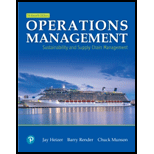
Concept explainers
Question:
1 State the seven steps, beginning with “Defining the Problem.” that an operations manager should perform when using simulation to analyze a problem.
To determine: The seven steps to perform using simulation to analyze the problem.
Introduction: Simulation is the model that can be used in operations, which would imitate the real world process. Simulation uses random sampling for the generation of realistic variability.
Explanation of Solution
The seven steps to perform using simulation to analyze the problem are as follows:
Step 1: Defining the problem
Step 2: Operations manager should introduce the important variables regarding the defined problem.
Step 3: Numerical models must be constructed.
Step 4: Possible course of actions to run the numerical models should be fixed.
Step 5: Operations manager should run the experiment.
Step 6: Result of the actions should be considered
Step 7: Operations manager should decide the course of action, which is beneficial among the alternatives.
Want to see more full solutions like this?
Chapter F Solutions
Mylab Operations Management With Pearson Etext -- Access Card -- For Operations Management: Sustainability And Supply Chain Management (13th Edition)
- Question 2 (25 Marks) Discuss how you would "reset the store estate" to remain competitive and relevant in the market? Question 3 (25 Marks)arrow_forwardWhat should leaders do after conducting an employee survey? take immediate action on results take at least 6 months to review the results to make sure the leader understands them review them immediately, but do not take action right away keep results confidential from employeesarrow_forwardOne of the best ways to encourage teamwork is to: continually promote from outside of the department recognize employees who focus on their personal performance goals only reward employees who complete their own tasks and also assist with problems outside of their department discuss individual performance issues at staff meetingsarrow_forward
- What can happen if a leader doesn't encourage teamwork? team members will support each other more the environment can become overly competitive and hostile turnover will descrease team members become more motivatedarrow_forwardunderstand 4 Classwork LSC Drag the name of the figure of speech to its example. 12 February 2025 personification Onomatopoeia Simile Metaphor Hyperbole Onomatopoeia metaphor 1. He tried to help but his legs were wax. Metaphor 2. The man flights like a lion on the soccer field. Simile 3. The books fell on the table with a loud thump. Onomatopoeia 4. Rita heard the last piece of pie calling her name. Personification 5. The rustling leaves kept me away. Personification 6. Kisses are the flowers of affection. 7. He's running faster than the windarrow_forwardAnswer the question in the attached photo and draw the network that interprets the dataarrow_forward
- not use ai pleasearrow_forwardoimmnjjjharrow_forwardSummarize the ethical dilemma encountered in Walmart Inc. Which of Kohlberg's stages of moral development is represented? Is there other theories of moral development that better describes the example? Postulate the (hypothetical or real) best- and worst-case outcomes of this dilemma. Is it agreeable with the selection of Kohlberg's stages of moral development for their examples? Is there another theory of moral development that would better describe their examples?arrow_forward
- Four-drive theory recommends that companies must keep fulfillment of the four drives in balance. What is this “balance” and why is it important? Can you Give an example (real or hypothetical) of how a company maintains balanced drive fulfillment. Also describe a company that does not provide this balance, including the consequences of this imbalance on employees’ attitudes and behavior. Thank youarrow_forwardwhat criteria would you utilize to determine if someone's pay is “fair” or “egregious?” Additionally, what should be the mechanism or process to determine how much greater an organizational executive should be paid versus line-level employees?arrow_forwardDefine the concept of a compensation philosophy, including the components that should be addressed in a compensation philosophy. Assess why a compensation philosophy is so foreign to most organizations and how you can best encourage an organization to create its own compensation philosophy that is beneficial to attracting the best talent.arrow_forward
 Practical Management ScienceOperations ManagementISBN:9781337406659Author:WINSTON, Wayne L.Publisher:Cengage,
Practical Management ScienceOperations ManagementISBN:9781337406659Author:WINSTON, Wayne L.Publisher:Cengage, Foundations of Business (MindTap Course List)MarketingISBN:9781337386920Author:William M. Pride, Robert J. Hughes, Jack R. KapoorPublisher:Cengage Learning
Foundations of Business (MindTap Course List)MarketingISBN:9781337386920Author:William M. Pride, Robert J. Hughes, Jack R. KapoorPublisher:Cengage Learning Foundations of Business - Standalone book (MindTa...MarketingISBN:9781285193946Author:William M. Pride, Robert J. Hughes, Jack R. KapoorPublisher:Cengage Learning
Foundations of Business - Standalone book (MindTa...MarketingISBN:9781285193946Author:William M. Pride, Robert J. Hughes, Jack R. KapoorPublisher:Cengage Learning


